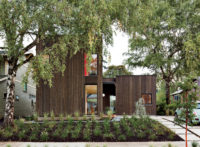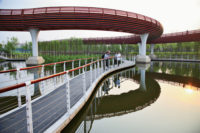Like the layers of atmosphere that protect our planet from the extreme temperatures and radiation from space, facades provide buildings with the filters and shields that make them habitable for living, play, and work. “The facade is the interface between humans and nature. Our job is to elevate that relationship as much as possible,” says Steve McDowell, principal at Kansas City–based BNIM. One could argue that this has been true as long as there has been shelter and architects. But now sustainability-minded firms like McDowell’s are demonstrating ways to enhance this experience while exploring new tools and approaches to fine-tune energy efficiency and user comfort.
When BNIM began discussing the design of the 60,000-square-foot Block D office building in Makers Quarter, a new urban district in downtown San Diego, the clients hadn’t been considering a high-performance building. But the firm, which has a history of energy-efficient design that dates to the 1970s, convinced them that such a structure would demonstrate environmental stewardship, provide long-term utility savings, and help attract tenants. Its unusual skin, which includes bright red sliding screens, along with other elements for harvesting daylight and controlling heat gain, is a key aspect of the building’s efficiency. It is designed to consume 41.6 percent less energy than a building that complies with the ASHRAE 90.1 standard. Block D’s 174 kW rooftop photovoltaic (PV) array is expected to make it a net zero building (one that produces as much energy, from renewable sources, as it consumes over the course of a year).
Site constraints dictated that the six-story concrete-framed structure, which opened last year, be elongate on the north–south axis, with its front, mostly glass facade facing west, toward the harsh afternoon sun—a less than ideal solar orientation. To mitigate the effects of glare, the architects devoted the areas on each office floor directly behind the skin to circulation rather than workspace, creating a buffer zone. They provided additional protection by extending the slabs beyond the glazing, with balconies that double as shading devices. But since overhangs do not shade once the sun sinks low, the team also devised the red perforated metal panels that can be manually reconfigured by the occupants to shade critical areas.
For the remaining third of the main facade, the glazing is pushed out to the slab edge, with venetian-type exterior blinds suspended from above on each level. Such shading elements have the advantage of controlling glare and, unlike interior blinds, blocking heat gain. A weather station on the roof controls the blinds as solar conditions change, and retracts them in high winds to avoid damage.
These blinds were almost value engineered out of the project when the contractor raised concerns about the $250,000 price tag. But the architects and engineers crunched the numbers and showed that cutting the blinds would add $400,000 in initial costs to the efficient, but mostly conventional, variable refrigerant flow (VRF) HVAC system.
As realized, Block D should only need to rely on this mechanical climate-control system for about 40 percent of the year, says BNIM principal Matthew Porreca. For the majority of occupied hours, the building is expected to be able to capitalize on the mild coastal–Southern California climate. To make the most of these conditions, the east and west facades include glazed garage-type doors that can open to permit cross ventilation. If wind speeds become too high, occupants can temper airflow by positioning the sliding sunshades in front of the doors. These openings also facilitate “night purge” by allowing the cool night air in, so that it can “flush” the heat stored in the concrete structure’s thermal mass.
Several similar strategies were used in BNIM’s design for another Southern California project—a maintenance and operations complex at Palomar Community College, in San Marcos, completed in 2018 and designed to achieve net positive energy (producing, from renewable sources, more energy than is consumed over the course of a year). The L-shaped, one-story complex consists of a larger maintenance volume and an office block, connected by a courtyard that is to be shaded by a 220 kW photovoltaic canopy system. The solar array, slated for installation next August, is designed to supply 105 percent of the complex’s power needs. The program makes the project ideal for this aggressive energy goal, since two-thirds of the 28,000-square-foot complex are devoted to the maintenance spaces, which have a wider temperature range than is acceptable in an office environment. This portion of the complex could therefore be heated and cooled with passive means alone. (As with Block D, the office portion has a VRF system.)
The maintenance volume’s natural ventilation scheme includes windows that open automatically at optimal times. And just behind its south-facing skin, solar chimneys with a glazed area extend above the facade. In warm months, vents at the top of these shafts are opened to induce the “stack effect,” allowing hot air to move upward toward cooler air and then be discharged. In winter, the chimneys’ vents are closed to collect heat, which is then distributed throughout the interior with fans.
The designers opted for a tilt-up wall system, with the surfaces of the concrete elements largely exposed on the interior to store thermal energy and take advantage of night-flush ventilation, as they did at Block D. They specified a vapor barrier on the exterior of the concrete wall, then 4 inches of mineral wool insulation board, which is water resistant. Between the terra-cotta plank-finished wall material and the insulation, there is a 1-inch air gap—screened and vented at the top and bottom of the wall—a typical detail in rainscreen systems. The gap serves two purposes: it helps the materials to dry out when moisture penetrates the skin of the building, and it allows convection to move warm air out of the cavity, reducing the amount of heat gain passing through the envelope. The assembly creates a “perfect wall,” a term coined by building scientist Joseph Lstiburek. It refers to the placement of the insulation and the control layers (for moisture, vapor, and air) outboard of the frame, in order to keep moisture out of the building and prevent thermal bridging (the movement of heat across an object that is more conductive than the surrounding materials and is a major source of heat loss in buildings).
Any high-performance facade design requires architects to do their homework, but the Boston-based firm Payette is raising the bar on in-house investigation with its building-science department: the four-person group collaborates with design teams on all the firm’s projects but devote about half their time to speculative research, not—according to Andrea Love, director of the department—directly related to current projects but potentially paying off for the firm in the future.
For instance, the building-science group created a tool to quantify the effects of glazing geometry and U-value (a measure of thermal performance) on occupant comfort and in reducing HVAC costs. The software, available free on the firm’s website, subsequently helped Payette determine that it could eliminate perimeter heating on its Amherst College Science Center, completed in 2018. The 230,000-square-foot, three-story building sits at the eastern edge of the main campus in western Massachusetts, which is stretched north and south because of the configuration of the site. To connect the building to the campus, the scheme includes a highly transparent west facade enclosing a three-story atrium. Blocks of labs and classrooms, which the architects call “pavilions,” plug into the atrium.
The atrium’s curtain wall is suspended from the cantilevered steel roof structure, allowing minimal mullions. To control the western sun, the architects specified internal roll-down shades that deploy automatically in four horizontal bands as the sun angle changes. In addition to avoiding glare, the setup also allows heat to be captured between the blinds and the glazing that is then vented via roof monitors to the exterior.
The Science Center is projected to have an Energy Use Intensity (EUI) 76 percent below that of a baseline building (EUI is a means of comparing energy use among buildings and is calculated by dividing annual energy use by square footage). To select glass that would help deliver this performance, the design team compared the available types of triple-glazed windows for optimal energy efficiency, shading, and transparency. In consultation with the mechanical engineers, the architects found that reducing the Solar Heat Gain Coefficient (SHGC)—which is typically controlled with low-E coatings—from 0.35 to 0.28 would achieve a 22 percent cut in peak cooling load. The reduction allowed the elimination of one air handler at a substantial savings.
Once the designers established these performance targets, they input data from different manufacturers into the thermal-performance software WINDOW and also ran it through the daylight- and glare-simulation program Radiance (both are open-source tools developed by Lawrence Berkeley National Laboratory). The results of the digital analysis, along with physical mock-ups, aided the architects in selecting a glazing system with the desired aesthetics and transparency.
The Science Center’s lab and classroom blocks are mostly clad with a perforated weathering-steel rainscreen system that includes stainless-steel connectors tying the panels to the structure. The project team arrived at this solution using imaging software to study various wall assemblies, to determine which produced the least thermal bridging. The results showed that stainless attachments would be one-third less conductive than typical steel.
Analytical and digital tools were also central to the design process for SmithGroup’s headquarters for the District of Columbia Water and Sewer Authority, recently completed on a wedge of land between the Anacostia River and an existing D.C. Water pump house.
In developing the six-story, 150,000-square-foot office building, designers first had to contend with an array of view sheds, setbacks (two-thirds of Washington’s wastewater flows beneath the site in a complex web of critical infrastructure), and programmatic challenges such as the requirement that the new facility integrate the historic pump house without having a negative effect on the operations or integrity of the older structure. The new, sinuous office building stretches the undulating south facade to face the river. Integrated into the north side of the building, a 200-foot-long truss spans over the old pump house.
The designers used parametric design tools to help shape the curvilinear skin, which was faceted into 4-foot-wide by 14-foot-high flat panels, primarily of glass. Adding to the complexity of the form, each successive floor of the south facade steps out 2 feet to create sunshades for the level below.
SmithGroup drew on the expertise of its team of in-house specialists, referred to as a Technology in Practice (TIP) group, to help design many of the facade elements. For example, the TIP assisted in defining the ideal overhang for shading and determining the potential for glare and heat gain. Using a variety of open-source software tools, the architects and the specialists designed a system of automated interior blinds programmed to maximize beneficial light and reduce negative effects.
The team digitally mapped areas of the south facade where transparency was important but heat gain was problematic. For these locations, the designers created an exterior layer of suspended tinted glass panels that function as “sunglasses” for the building, says SmithGroup principal Sven Shockey. Fastened to the overhang above, the laminated green glass is 3 feet from the face of the window and incorporates the tinted inner layer to reduce heat gain while maintaining the views to the river.
In addition to the high-performance facade, the headquarters building includes such innovative technologies as a heating and cooling system that takes advantage of the wastewater flowing beneath the site. It depends upon a closed-loop heat exchanger and helps the design achieve a 45 percent energy-use reduction compared to a benchmark building complying with ASHRAE 90.1. With these features and others, including a rainwater collection system with two 20,000-gallon cisterns, the project team is targeting LEED Platinum.
SmithGroup’s impressive results for D.C. Water, and those of BNIM and Payette in Southern California and western Massachusetts, show that it is still possible to push the envelope on high-performance facade design. Old-school experience, deep research, and evolving design tools are not only making buildings more comfortable for their occupants but, by conserving resources, are improving the environment for all of us.
|
Continuing Education
 To earn one AIA learning unit (LU), including one hour of health, safety, and welfare (HSW) credit, read "Continuing Education: High-Performance Facades," review the supplemental material listed below, and complete the online test. Upon passing the test, you will receive a certificate of completion, and your credit will be automatically reported to the AIA. Additional information regarding credit-reporting and continuing-education requirements can be found online at continuingeducation.bnpmedia.com. To earn one AIA learning unit (LU), including one hour of health, safety, and welfare (HSW) credit, read "Continuing Education: High-Performance Facades," review the supplemental material listed below, and complete the online test. Upon passing the test, you will receive a certificate of completion, and your credit will be automatically reported to the AIA. Additional information regarding credit-reporting and continuing-education requirements can be found online at continuingeducation.bnpmedia.com.Supplemental Material
Executive Summary (through page 4) Learning Objectives 1. Discuss glare-control and daylight-harvesting strategies for sites that dictate a less-than-optimal solar orientation. 2. Describe digital tools useful in facade design, including those for understanding thermal performance and for daylight simulation. 3. Describe the components in a “perfect wall” system and explain how these are typically assembled. 4. Understand technical terms and concepts relevant to facade design and building physics, including U-value, thermal bridging, and stack effect.
AIA/CES Course #K1904A
For CEU credit, read "Continuing Education: High-Performance Facades" and take the quiz at continuingeducation.bnpmedia.com, or use our Architectural Record Continuing Education app, available in the iTunes store. structure, finishes, and other original fabric when
a building is moved.
significant buildings.
|













Post a comment to this article
Report Abusive Comment